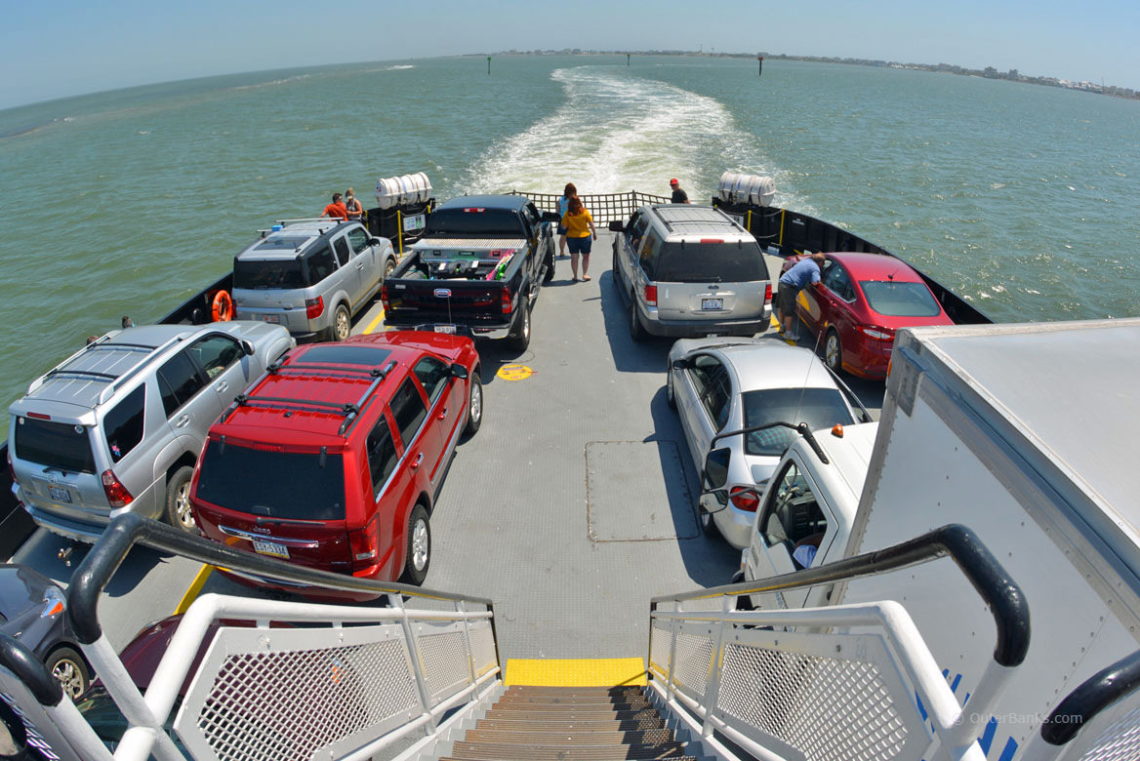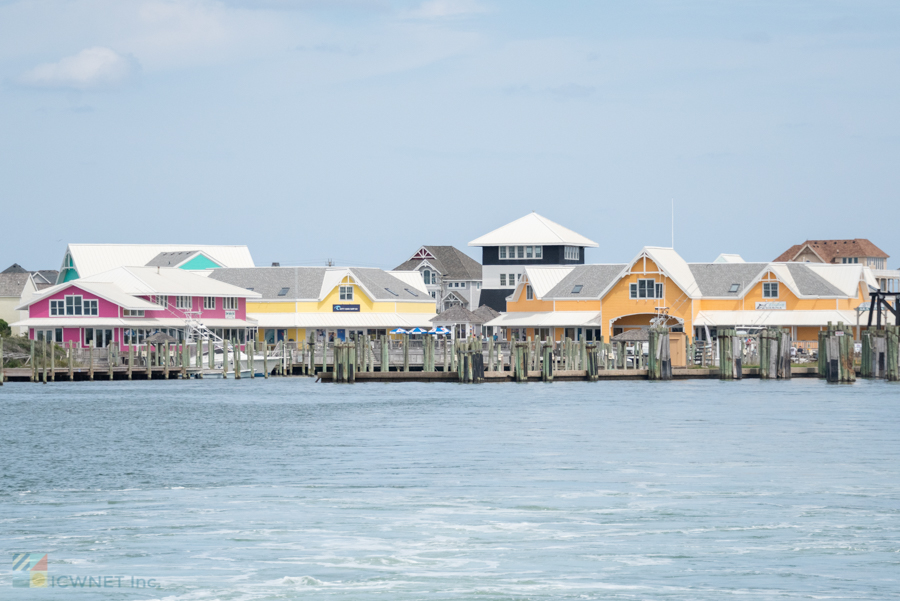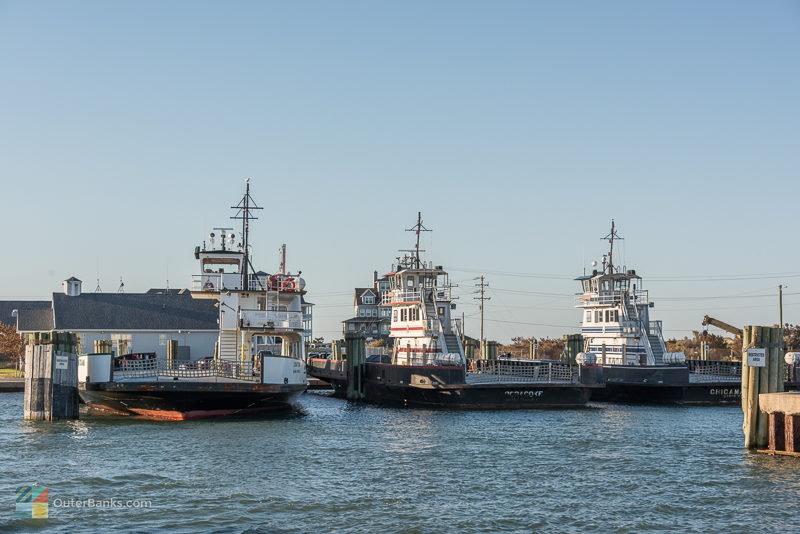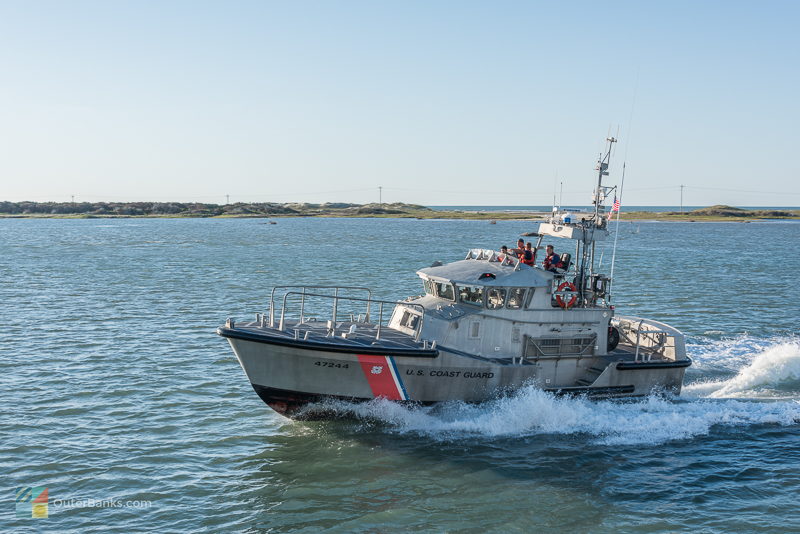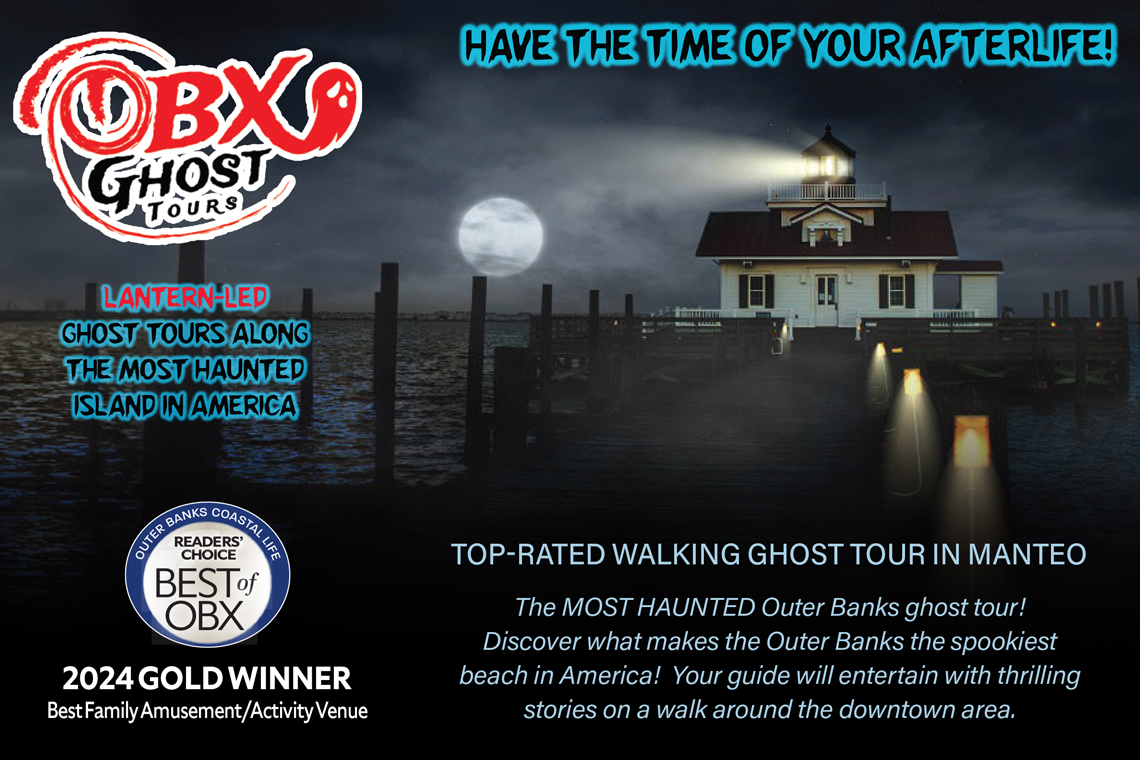The southernmost attraction on Hatteras Island is Hatteras Inlet, and fishermen, mariners, beachcombers, and island lovers all know this area of the Outer Banks shoreline very well. Located approximately half mile past the edge of the populated Hatteras village and the Hatteras/ Ocracoke ferry docks, Hatteras Inlet provides plenty of outdoor entertainment and simply incredible scenery for those who pull up a beach chair, or are just passing through en route to Ocracoke Island or the Gulf Stream.
On your next Hatteras Island vacation, why not take a drive down to the inlet for a visit to an area that's almost truly off the map, or plan a charter trip or day trip to Ocracoke to ride across the inlet waters? Beautifully scenic from all directions, and offering plenty of shore-side activities while providing a gateway to the open ocean and sound waters, Hatteras Inlet is a multi-faceted attraction that all vacationers can enjoy.
Inlets along the Outer Banks are constructed in one of two ways: by either gradual erosion and ocean over wash or with the advent of a massive storm. The second method of formation is far more prevalent, and the majority of the current inlets on the OBX have been created with a massive gale, hurricane or nor'easter that plowed through the area leaving a new gap in between the barrier islands in its wake.
Hatteras Inlet was created by such an event. For centuries, an inlet was located further south of its present day location, but as the islands shifted and moved, this original inlet closed in the 1760s. Less than a century later, a new Hatteras Inlet was opened up again by a violent storm that passed through the Outer Banks on September 7, 1846.
Locals say there's a silver lining around every storm cloud, and in this case, this new inlet provided easy transport from the ocean to the Pamlico Sound, and ergo the mainland communities of coastal North Carolina. Shipping almost immediately grew in the area, as haphazard ports were formed and more and more residents began to call Hatteras Village their permanent home.
The shipping industry gradually dwindled in favor of larger and more prominent ports in other North Carolina and South Carolina regions, but the former shipping industry was eventually replaced with a small but robust tourism industry. Via the Hatteras Inlet, charter fishing boats could make easy runs to the Gulf Stream just 10-15 miles away, (one of the shortest runs in North Carolina), and surf fishermen could flock to the inlet beaches and reel in the large game species that were regularly passing through.
Because of Hatteras Inlet, the village of Hatteras is a fully-functioning and well-respected fishing village. Its proximity to Hatteras Inlet has earned it the nickname the "Blue Marlin Fishing Capital of the World," (helped in no small part by the record blue marlin catches that have been reported offshore), and the southern borders of the village are literally lined with a half dozen marinas, all well-stocked with local fishing boats, charter boats, and even tour boats just waiting for water loving patrons.
Thanks to the sudden and stormy arrival of the Hatteras Inlet over 150 years ago, Hatteras Village has been able to build a character that revolves around fishing, water, and a thriving salty life on a sandbar.
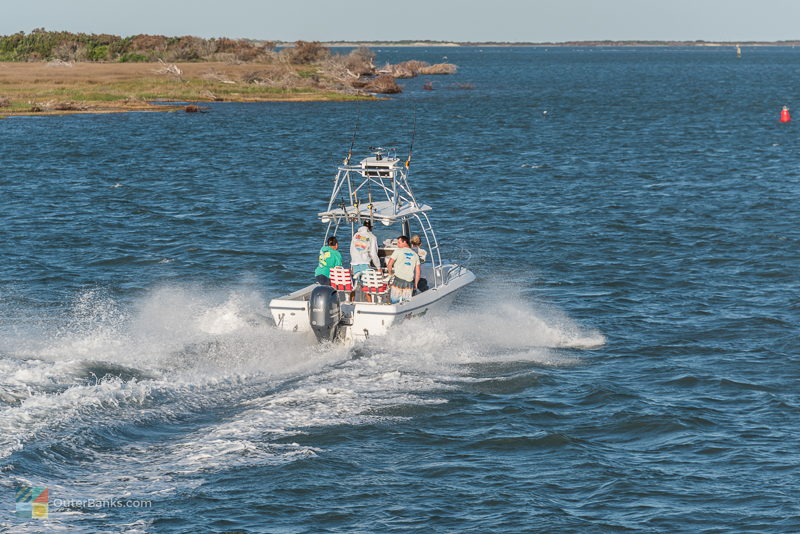
Visiting Hatteras Inlet
Hatteras Inlet is approximately 2 miles wide, creating a water divide between Hatteras Island and Ocracoke Island. There are no bridges that run across it, however, visitors are encouraged to take advantage of the free ferries, managed by the North Carolina Department of Transportation, that run across the inlet from one island to another daily.
Each ferry can accommodate between 30-60 vehicles, and the ferries run every 30 minutes in the summer season and every hour in the off-season, from 5:00 a.m. until midnight. The trip is approximately 40 minutes long, and skirts along the edge of Hatteras Island before heading into the open inlet waters. On windy days, this section of the trip can be a little bouncy, but it only lasts a few minutes and provides some spectacular open water views.
All visitors are welcome to use the free ferry for a little island hopping, but are advised that summer weekdays can be popular traveling times, and vehicles are loaded on a first-come, first-serve basis. For a trip across the inlet without the wait, consider taking the ferry in the evening from Hatteras, or in the morning from Ocracoke, or plan an off-season visit when a visitor may even be the lone vehicle on the Hatteras / Ocracoke ferry.
Visitors can also head to the beaches on either side of the inlet. Managed by the National Park Service and seasonally open depending on endangered and threatened species breeding activity, the two beaches literally circle the inlet, and span from crashing ocean waves to lapping sound waters.
The Ocracoke Island beach along Hatteras Inlet can be accessed on foot via the public parking area adjacent to the ferry docks, or by a 4WD vehicle via a public access ramp that's located approximately quarter mile down the road. The beach on Ocracoke is renowned for its tidal pools, which can appear and reappear within minutes, and provide impromptu wading locations as well as incredible shell beds. With this in mind, however, trucks are advised not to park to close to the water, as the landscape can change in an instant, with sand being replaced with saltwater canals snaking through the beach.
The Hatteras Island beach along the inlet is a little harder to get to, and a 4WD vehicle is all but required to reach the very tip of the inlet. That said, hikers who love a good beach walk or folks who don't need to be too close to the actual inlet borders can simply park at the public parking area across from the Graveyard of the Atlantic Museum at the very edge of town.
This beach is unique in that, depending on which direction you turn, beachgoers can enjoy two entirely different experiences. The 4WD route through the southern portion of Hatteras has trails that veer off towards the soundside and the oceanside, allowing vacationers to either spend a day at the calmer sound beaches, which are shrouded and protected by small clumps of myrtle bushes and cedars, or head straight to the oceanfront for a standard Outer Banks beach day. Both locales offer incredible fishing, as well as gorgeous views and miles of open water privacy, and since they're so close together, visitors can easily try both during a single beach trip.
Regardless of which side of the inlet you land, visitors are advised that a Beach Driving Permit is required to access either portion of the Hatteras Inlet seashore via a 4WD vehicle. Permits can be obtained at the National Park Service offices, (located in Buxton village or in Ocracoke Island), and can be purchased on a weekly or annual basis.
The other way to visit the inlet is to plow right through, and a number of both offshore and inshore charter fishing businesses along Hatteras village are more than happy to provide curious inlet visitors with a ride.
While an offshore charter will briefly pass through en route to the Gulf Stream, an inshore charter, like Got 'Em Charters based out of Hatteras Village, can linger and introduce patrons to the little known oceanside beaches, soundside clamming grounds, and small temporary islands along the way.
Most folks passing across the inlet on the Hatteras / Ocracoke ferry around low tide will notice a handful of these "sandbar" islands speckled throughout the inlet. Though most disappear with the incoming tides, a small few stay permanently fixed during all weather conditions.
If you can get there, these small islands have some of the best shelling on the Outer Banks, with undiscovered treasures deposited regularly with every new tide. On the soundside of the inlet, visitors can go crabbing, bait-fishing, and clamming by simply finding a shallow area for their skiff to anchor, hopping off, and shuffling along the soft almost muddy sound floor with their feet. If your toe catches a slightly large object, start digging and chances are you'll end up with a clam ready for steaming in the palm of your hand.
Regardless of whether you're just passing through for a couple of spectacular open water photos, or anchoring for the day to enjoy the shells and fishing, the beaches and little nooks of Hatteras Inlet can cater to just about every Outer Banks outdoors lover.
Things to do by Hatteras Inlet
The most popular activity for Hatteras Inlet visitors is fishing, and there's a wide range of options to enjoy the incredibly diverse fishing holes in the area.
Visitors can enjoy a little surf fishing right off the beaches, either on the Ocracoke or Hatteras side of the inlet, to try and reel in larger species that are cutting through the waters. These two locales, when open, are incredibly popular with surf fishermen, and it's not unusual to see a dozen or so beach fishermen on a clear fall day on either side of the inlet, casting their lines.
The oceanside and soundside beaches on either side of the inlet are also both popular surf fishing locales, particularly the soundside where the lack of ocean waves allow fishermen to slip on a pair of waders and venture out 40' or 50' feet to extend their cast into the water. As mentioned, clamming is also a fruitful venture along any soundside area of the inlet, and cast netters and crabbers can also have a bit of luck just yards away from the shore.
Fishermen who want an easy run to the Gulf Stream will also find themselves passing through Hatteras Inlet, as this section of the Outer Banks coastline is one of the closest to exceptional offshore fishing. Dozens of local charter businesses operate right off the docks of Hatteras Village, making a run from the boat slip to the inlet a 10 minute journey. Privately owned vessels will also find boat slips available for rent along the Hatteras village harbors for self-guided treks to the open ocean fishing grounds.
Experienced beachcombers are also well-acquainted with the beaches on either side of Hatteras Inlet, as the combination of both ocean and sound facing shorelines, as well as proximately to the deeper Atlantic waters, can produce some truly exceptional finds. On the soundside, beachcombers can expect to find smaller finds that are perfectly intact, including delicate sand dollars, olive shells, periwinkles, and even rainbow-hued pen shells. On the oceanside, larger varieties wash up on a regular basis, including all three varieties of whelks, clams, scallops and large moon snails or olive shells. Beachcombers are encouraged to take their time and explore both regions of the inlet to maximize their chances of finding a unique Outer Banks treasure.
Besides fishing and beachcombing, the beaches bordering the inlet are also ideal for scenery lovers who want a wide-open locale to stretch out and relax. With miles of beaches to share with a handful of Hatteras Inlet devotees, beach goers will find ample patches of sand to spread out and enjoy. The soundside beaches along Hatteras Inlet are especially appealing, as not only are they protected by a barrier of shrub thickets, but they also provide wide open views of all the ferries, skiffs, and charter boats cruising in and out of the inlet, allowing vacationers to just sit back and watch the ships roll in.
Tips and Tricks for Visiting Hatteras Inlet
- While visitors are encouraged to enjoy the beaches, the small tidal pools, and the exceptional fishing and beachcombing, do not swim in the Hatteras Inlet. Not only do big species pass through on a regular basis, but the waters that run through an inlet are among the strongest on the Outer banks coastline. Though deceptively calm on the surface, if a visitor ventures too far, they can easily be swept away towards the ocean or the sound within minutes.
- In this vein, kayakers, stand-up paddle boarders, windsurfers and kiteboarder should avoid venturing in the inlet as well. The only safe way to travel through the inlet, and maneuver through the rapid current, is via a motorized boat.
- If doing a little island hopping, if possible, try to hit the Hatteras / Ocracoke ferry around sunset or sunrise. The open waters of the inlet are dappled in a rainbow of colors, producing some pretty incredible views, (and some wonderful photos to boot.)
- Be sure and check to see what sections of the inlet beaches are open during your vacation. The National Park Service has a regularly maintained beach closure map on their website, which is updated weekly to reflect the changing closure areas.
- Beachcombers shouldn't be afraid to get their feet wet. Sometimes, the best finds can be found just barely off the shore, with sand dollars, intact whelks and other prize shells literally partly buried just a foot or two off the beach in the water. For best results, wade in the ocean or sound wash, and let your toes do the searching, by digging in the sand and unearthing any prize finds.
- To experience all of the inlet fun, book an inshore charter trip. Generally less expensive than an offshore charter fishing trip due to less gas and time accessing the Gulf Stream, an inshore trip can take inlet-curious visitors to all the good fishing holes, clamming beds, and shelling sandbars that Hatteras Inlet has to offer.
Hatteras Inlet may be relatively new by most waterway standards, having only been formed 150 or so years ago. However, the inlet has been the basis for an entire fishing community, with thousands of vacationers flocking to the area to experience some of the best fishing on the Outer Banks, both off the beach and well offshore.
Visitors who love a quiet stretch of beach, an exceptional day of fishing, or just a panoramic view of the edges of Hatteras and Ocracoke Islands should consider planning a visit to the Hatteras Inlet on their next vacation. By land or sea, an expedition of this section of Outer Banks shoreline is certain to produce sunny beaches, amazing open water views, and a vacation day filled with wonderful waterfront memories.

